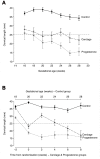Limited relationship between cervico-vaginal fluid cytokine profiles and cervical shortening in women at high risk of spontaneous preterm birth
- PMID: 23300664
- PMCID: PMC3530581
- DOI: 10.1371/journal.pone.0052412
Limited relationship between cervico-vaginal fluid cytokine profiles and cervical shortening in women at high risk of spontaneous preterm birth
Abstract
Objective: To determine the relationship between high vaginal pro-inflammatory cytokines and cervical shortening in women at high risk of spontaneous preterm labor and to assess the influence of cervical cerclage and vaginal progesterone on this relationship.
Methods: This prospective longitudinal observational study assessed 112 women with at least one previous preterm delivery between 16 and 34 weeks' gestation. Transvaginal cervical length was measured and cervico-vaginal fluid sampled every two weeks until 28 weeks. If the cervix shortened (<25 mm) before 24 weeks' gestation, women (cases) were randomly assigned to cerclage or progesterone and sampled weekly. Cytokine concentrations were measured in a subset of cervico-vaginal fluid samples (n = 477 from 78 women) by 11-plex fluid-phase immunoassay.
Results: All 11 inflammatory cytokines investigated were detected in cervico-vaginal fluid from women at high risk of preterm birth, irrespective of later cervical shortening. At less than 24 weeks' gestation and prior to intervention, women destined to develop a short cervix (n = 36) exhibited higher cervico-vaginal concentrations than controls (n = 42) of granulocyte-macrophage colony-stimulating factor [(GM-CSF) 16.2 fold increase, confidence interval (CI) 1.8-147; p = 0.01] and monocyte chemotactic protein-1 [(MCP-1) 4.8, CI 1.0-23.0; p = 0.05]. Other cytokines were similar between cases and controls. Progesterone treatment did not suppress cytokine concentrations. Interleukin (IL)-6, IL-8, granulocyte colony-stimulating factor (G-CSF), interferon (IFN)-γ and tumour necrosis factor (TNF)-α concentrations were higher following randomization to cerclage versus progesterone (p<0.05). Cerclage, but not progesterone treatment, was followed by a significant increase in cervical length [mean 11.4 mm, CI 5.0-17.7; p<0.001].
Conclusions: Although GM-CSF and MCP-1 cervico-vaginal fluid concentrations were raised, the majority of cervico-vaginal cytokines did not increase in association with cervical shortening. Progesterone treatment showed no significant anti-inflammation action on cytokine concentrations. Cerclage insertion was associated with an increase in the majority of inflammatory markers and cervical length.
Conflict of interest statement
Figures






References
-
- March of Dimes (2009) White Paper on Preterm Birth: the Global and Regional Toll. United States: March of Dimes.
-
- Romero R, Espinoza J, Mazor M, Chaiworapongsa T (2004) The preterm parturition syndrome. In Preterm Birth. Critchley H, Bennett P, Thornton S, editors. RCOG Press, London. 28–60.
-
- MRC/RCOG Working Party on Cervical Cerclage (1993) Final report of the Medical Research Council/Royal College of Obstetricians and Gynaecologists multicentre randomised trial of cervical cerclage. BJOG 100: 516–23. - PubMed
-
- Berghella V, Odibo AO, To MS, Rust OA, Althuisius SM (2005) Cerclage for short cervix on ultrasonography: meta-analysis of trials using individual patient-level data. Obstet Gynecol 106: 181–9. - PubMed
Publication types
MeSH terms
Substances
LinkOut - more resources
Full Text Sources
Other Literature Sources
Medical
Research Materials
Miscellaneous

